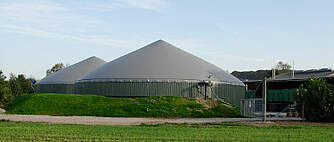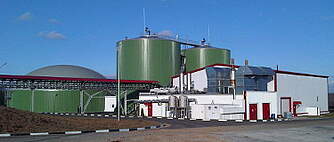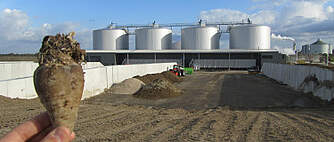In industrial biogas plants, industrial residues are used as a source of energy. Typical substrates are residues from the food industry, slaughterhouse waste, fats, glycerine, market waste, crop residues and many similar substances.
Revenue from operating a plant can be increased in two ways: firstly, by taking these substrates from those who are looking to get rid of them and secondly, through increased biogas production. Where possible, liquid manure is added as a basic substrate. Usually these plants are connected to an agricultural operation. Plants connected to an industrial operation are often designed for exclusively utilising the substrates generated.
Liquid manure is ideal as a basic substrate. Where possible, liquid manure from surrounding farms is delivered by trucks or pumped to the biogas plant, while industrial residues are usually brought to the plant by truck. In order to reduce odour emissions, industrial residues are stored in closed containers or even within an enclosed hall.
Depending on consistency, the substrates are pretreated. For example they are chaffed, ground, screened or otherwise pretreated, and where necessary impurities need to be removed. Powerful agitators in the mixing tank are essential for the subsequent homogenisation. If hygienisation is required, this is usually carried out at a temperature of 70° C and for a duration of one hour for a maximum particle size of 12 mm. However, the fermentation process often reduces germs sufficiently. Subject to consistency, substrates are delivered into the digester by pump, mixed with liquid manure or process water or with a solid input device. Digesters in large plants are usually made of coated steel. If several tanks are used, these are usually interconnected. Digester volumes vary, ranging from 500 m³ up to several thousand m³. The digesters are equipped with agitators for homogenisation. Depending on the substrate and the process technology, these may be large central agitators or lateral agitators, for example.
The biogas produced is collected in gas holders. These are usually constructed in the form of a double-membrane gas holder roof on the secondary digesterdigester and the digestate storage tanks. A large storage volume for biogas makes for greater gas consumption flexibility. The biogas generated is normally used in a gas engine to generate electricity and heat in cogeneration. In the event that the engine or engines are not in operation yet biogas is still generated, the plants are equipped with an emergency flare, which can be used to burn off the excess biogas. The industrial biogas plant system includes a cooler, a condensate shaft, a desulphurisation system and other components. The appropriate biogas composition is controlled by a gas measuring device. Of course, the biogas generated can also be used thermally (steam, heat) or processed to meet natural gas specifications.
The digestate is pumped into storage tanks, which are generally equipped with a gas holder roof. The gas holder roof reduces emissions and increases the biogas storage capacity. Although gas production in the storage tank is not particularly high, in terms of energy and environmental protection it makes sense to capture this and utilise it.
Every major industrial biogas plant is monitored by a comprehensive automated control system, featuring a variety of measuring and control devices. However, from time to time it is essential for the operator to be on site, e.g. for inspection rounds, to receive the substrates or for maintenance or repairs.
Large-scale industrial biogas plants are constructed for one purpose only, and that is to earn money. In order to achieve this goal, the system must run day and night, with the investment costs possibly amounting to several million euros. Depending on the input material, the pretreatment method also needs to be planned by engineers. Moreover the retention time varies, depending on the type of input material and pretreatment. This time, in turn, has a direct impact on the digester volume.
In principle, planning or constructing this kind of industrial biogas plant requires the assistance of an experienced team of experts. Krieg & Fischer Ingenieure can offer you many years of extensive experience in the planning and construction of such plants.


